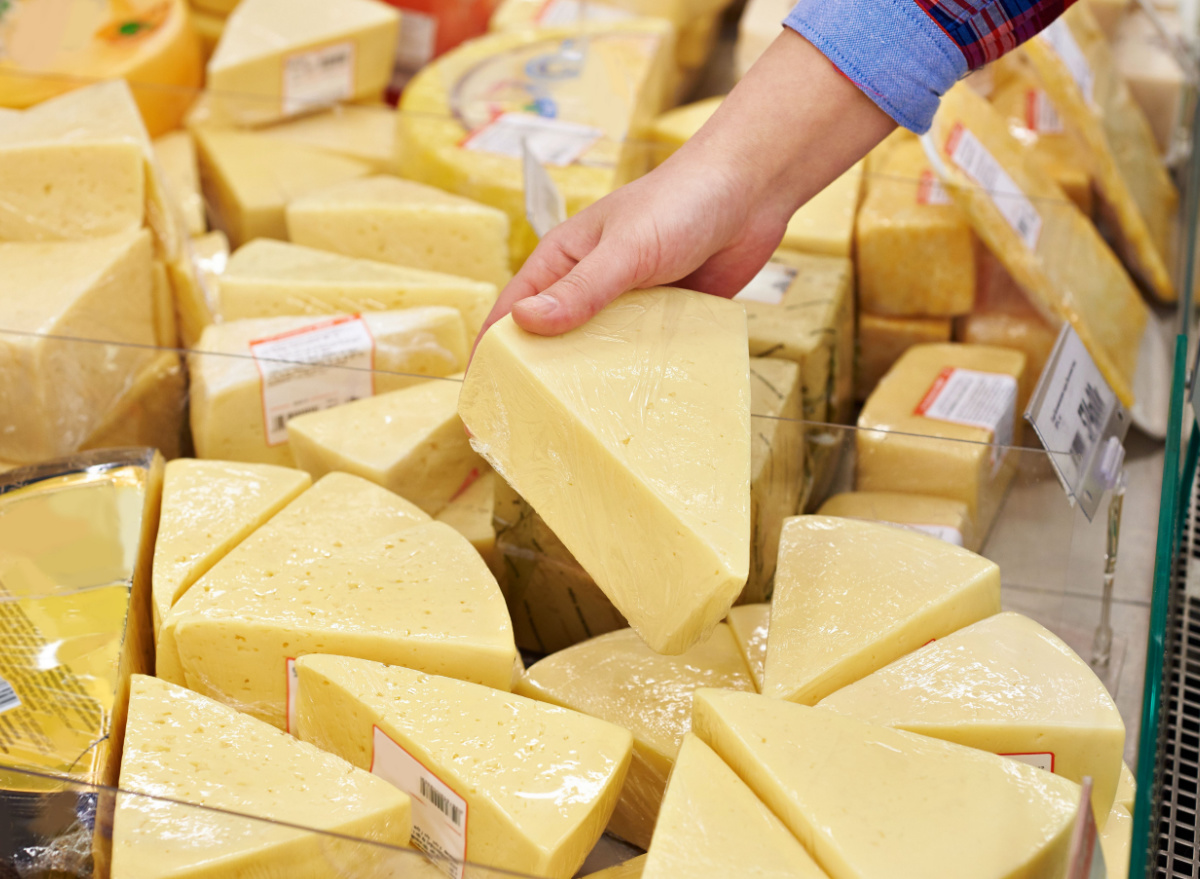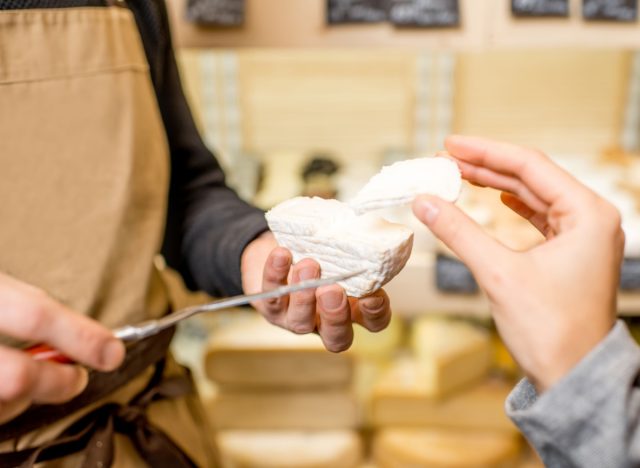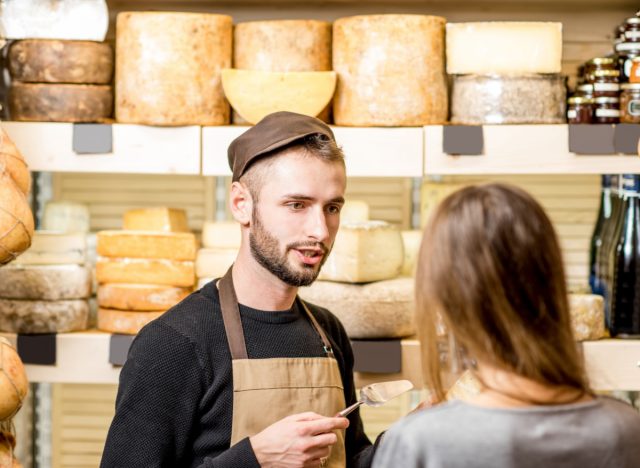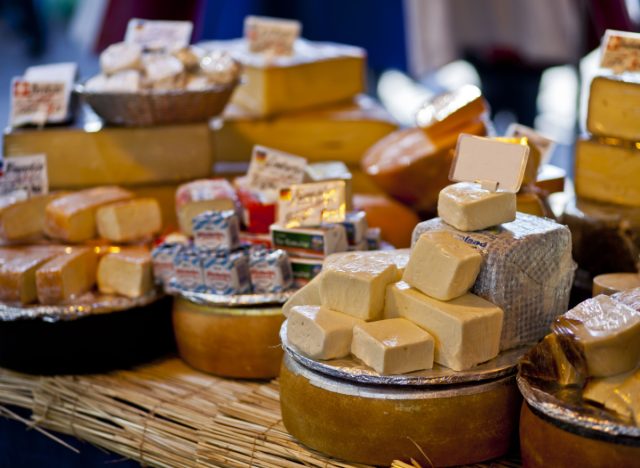How To Choose the Best Cheese at the Grocery Store, According to a Cheesemonger

Whether you believe it’s a guilty pleasure or a protein- and calcium-rich nutrient source, there’s no denying the popularity of cheese. It’s a delicious addition to pasta, or your charcuterie board, or simply on its own. You’re probably already familiar with the basic varieties, like brie, cheddar, and Swiss, but there’s a whole world of cheeses to be explored.
Kathleen Serino trains cheesemongers across the country as the national manager of core curriculum for Murray’s Cheese, an artisanal cheese and specialty foods company based in New York City, which also operates more than 1,000 cheese shops at Kroger locations nationwide. Serino has worked with cheese for more than a decade, and she loves helping shoppers find their favorites among the hundreds of options at Murray’s.
If you’re looking to make better decisions about buying cheese at your local grocer, you can get there with Serino’s expert tips.
Get to know your cheese

How many cheeses can you name? For such a simple delicacy, there are nearly 1,800 kinds, which can be classified by type of milk, region of origin, age, texture, flavor, or preparation method. And yet, they all share a similar ingredient list. Understanding how different cheeses range in form will start to give you a foundation for learning what you’re looking for.
“Believe it or not, many cheeses we know are generally made from the same four ingredients: milk, cultures, rennet, and salt…But it’s really what the cheese maker does with those main ingredients,” explains Serino. “So it’s all the ways in which they decide to tweak things and adjust things. Maybe they use a mix of cow milk and sheep milk, or maybe they do a special blend of cultures, which is the microbes that work in cheese….In a nutshell, it basically goes down to the recipe. So many steps can happen in between from start to finish to get you a different result.”
Cheesemongers know that the range of options can be overwhelming, so cheese sections are often arranged to help shoppers navigate all the choices in the deli case. This varies by store, according to Serino. “At Murray’s, they’re categorized as the best way that we can communicate to our customers,” she shares. “A lot of people know what a cheddar or gouda is, but a lot of people don’t realize the variation that you can see within that family. There’s a broad spectrum of gouda and cheddar, so you can really geek out when you go down the rabbit hole of those cheeses.”
Once you’ve become acquainted with all of the possibilities, you’re free to “cheese your own adventure,” as the Murray’s cheesemongers say. That is, consider a cheese based on how you’d like to enjoy it. Whether you’re cooking versus baking versus snacking, the cheese you’ll want to pick up will depend on its intended use. And while you’re getting smart on the different ways to incorporate various cheeses, the professionals behind the counter can point you in the right direction.
“If a customer is looking for something indulgent and creamy, then we’re going to recommend a softer cheese,” says Serino. “If they want something for cooking, finishing a pasta or roasted vegetables, then we might recommend a firmer cheese that’s better for grating, like a Pecorino Romano. If they really like those crunchy crystals found in aged cheeses, then we would recommend an aged gouda or aged clothbound cheddar, something that’s going to have that satisfying texture or contrast in there.”
Try before you buy

Another big tip that experts follow themselves is to taste-test often. Unlike most items at the grocery store, you can sample almost anything at the deli counter before you decide to make a purchase. Not only is it useful for making sure your regular Swiss is up to snuff, but you can use this technique as a discovery tool—especially if you’re at a store with a dedicated cheesemonger.
“I think it’s really important to allow and encourage customers to do that. And customers should feel empowered to ask to try, so they don’t feel like they’re making a blind investment,” Serino emphasizes. “I think that that’s one of the best ways that a cheesemonger can gauge a customer’s reaction because what we want to know is, do you like this? Are you looking for something with a little more personality? Or is this kind of like at your threshold of tolerance? Then we can really tailor our customizations [and] make recommendations.”
Ask your cheesemonger

The cheesemonger is a key piece of this equation. You don’t always have to frequent higher-end shops to find your favorite cheese, but in the beginning, it’s helpful to learn from someone who’s been trained to know their gorgonzola from their gouda as you develop your taste and preferences.
Grocery stores like Wegmans, Whole Foods, and Kroger sometimes even have these experts on the floor. They tend to the case, make pairing recommendations, and demystify the complexity of flavors and textures—like a sommelier, but for the myriad varieties of cheese.
“We have a really robust training program that we put them through [at Murray’s]. They’re really engaged in learning—we call them ‘curd nerds’ because they’re so into cheese,” says Serino. “So one of the best things you can do is talk to the person that’s working the cheese case and ask, ‘What is your favorite cheese right now?’ They’ll definitely know what’s tasting really good and what is really good right now to buy…and they’re there to help.”
Sampling your way through the case may lead you to unearth a taste for something unexpected. Your cheesemonger will know to start with “gateway cheeses,” a term coined by cheese expert and former Murray’s Cheese vice president Liz Thorpe, which describes nine types of cheese with their own class of characteristics.
“They’ll introduce you to a larger group, arranged along a spectrum of increasing flavor intensity, so you can confirm what you like, branch out across gateways with confidence, and avoid the cheeses that, for you, just don’t taste good,” Thorpe explains on her site.
Serino says that experts at a quality cheese section are trained to use those gateway cheeses to get to flavors and textures you love in uncharted territory. “We can introduce a Taleggio as a perfect example of a cheese that is in the washed rind family, whose bark is worse than their bite because of the rind aroma, almost borderline funky, maybe even potentially off-putting to someone. But then once you try it, you realize how pleasant and salty and savory it is, and it makes you want to go back in for another bite. That’s a perfect example of a gateway cheese.”
They can then use your reaction to ease you into cheese with more intense, distinct flavors. “It’s like, if you really liked Taleggio, let me introduce you to Willoughby because it is a little bit stronger, a bit meatier, it’s got a lot more creaminess. So keep trying [cheeses] and make friends with your cheesemongers at your grocery stores.”
Look for cheese that’s stored and kept well

Once you know the kind of cheese you’re looking for, now it’s time to assess the quality. Flavor can be a good signal, though much of it depends on the type of cheese and your personal preference. Serino says that cheese can taste off or overly salty if it’s defective.
On the other hand, flavor can help you identify a great buy. “If it tastes really purely of those wonderful milky, kind of smooth, pleasant, and sweet cream flavors that you want in a cheese, I think that’s an indication that the cheese has good quality.”
One secret trick of the skilled buyer is to be wary of cheeses that are affected by light or oxygen. Most cheese blocks and wheels are wrapped in cheesecloth and paper to reduce how much it degrades over time through oxidation, a process that damages the fats and proteins in the cheese, leading to discoloration, bad taste, and an off-putting smell.
“What I like to do when I’m buying cheese at the store is—if I’m buying a piece fresh cut from a wheel, I’m looking for the piece that has the minimum exposure to light,” Serino reveals. “I usually pick a piece that’s underneath, because I know that it hasn’t just been under the fluorescent lighting.”
This can also happen if the cheese isn’t sufficiently protected from the surrounding air, she says.“If I see a piece of cheese [where] its wrapping is wrinkled, loose, or not securely fastened, then it’s exposed to oxygen, and I would be less interested in purchasing a piece like that.”
But don’t be so quick to slough off pieces of cheese left and right. Cheesemongers are trained to recognize when their wares aren’t in tip-top shape, and it’s a simple process to restore it to ideal quality.
“In our New York stores, that’s just a natural part of conditioning for the case,” Serino says. “When we merchandise all our cheeses for the case, we always inspect cut surfaces. And if we see that kind of indication where there’s discoloration, we trim that a little bit and make sure that what we’re offering is the best for customers.”
In the end, the best cheese is up to the individual consumer. So keep trying a wide variety until you land on a winner. “There’s a lot of diamonds [in the rough] in our cases—there’s a lot of really, really good cheeses,” Serino says. “And I feel like personal preference is very unique, right? It’s not a one-size-fits-all. My diamond is different from your diamond.”









